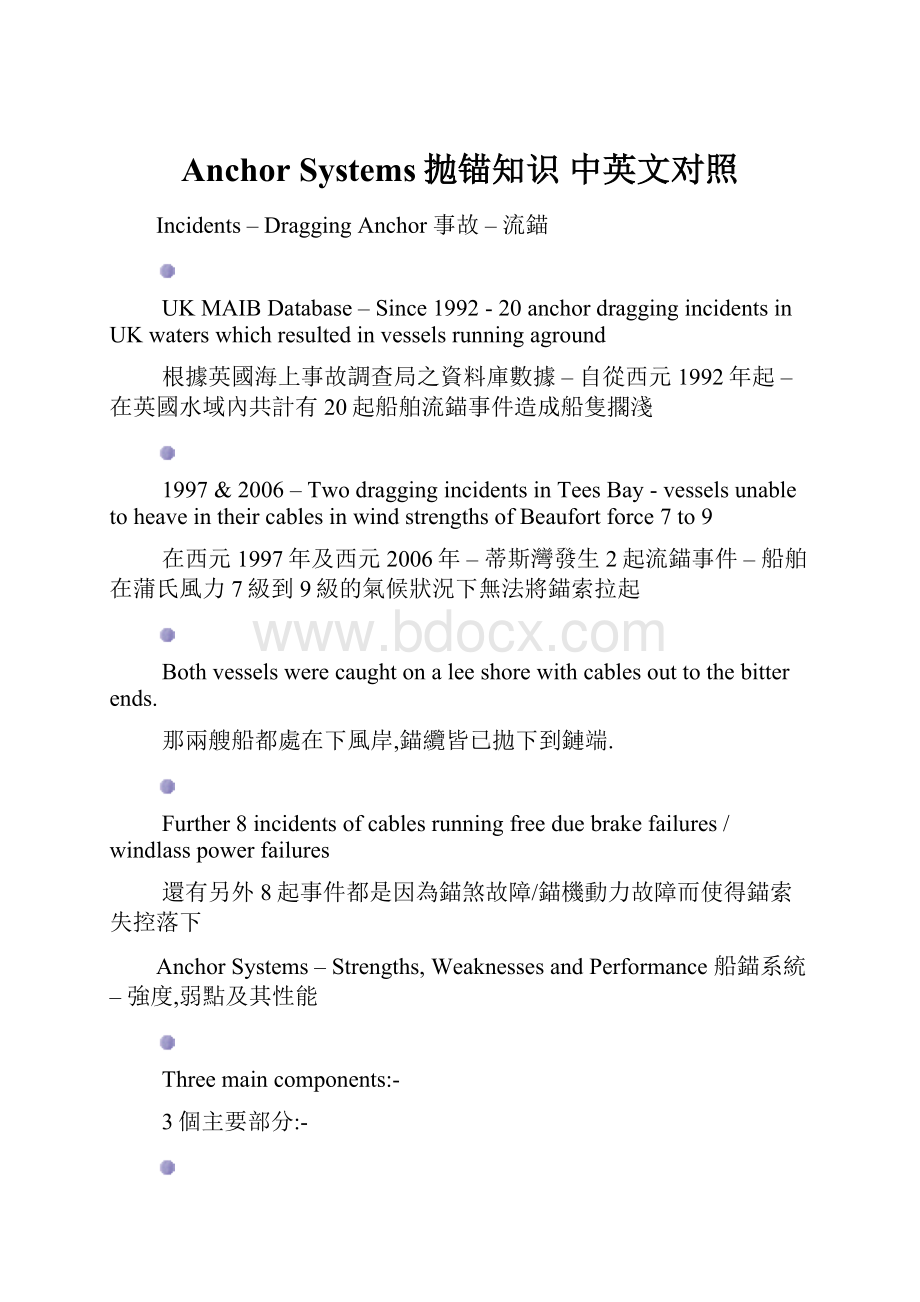Anchor Systems抛锚知识 中英文对照.docx
《Anchor Systems抛锚知识 中英文对照.docx》由会员分享,可在线阅读,更多相关《Anchor Systems抛锚知识 中英文对照.docx(26页珍藏版)》请在冰豆网上搜索。

AnchorSystems抛锚知识中英文对照
Incidents–DraggingAnchor事故–流錨
UKMAIBDatabase–Since1992-20anchordraggingincidentsinUKwaterswhichresultedinvesselsrunningaground
根據英國海上事故調查局之資料庫數據–自從西元1992年起–在英國水域內共計有20起船舶流錨事件造成船隻擱淺
1997&2006–TwodraggingincidentsinTeesBay-vesselsunabletoheaveintheircablesinwindstrengthsofBeaufortforce7to9
在西元1997年及西元2006年–蒂斯灣發生2起流錨事件–船舶在蒲氏風力7級到9級的氣候狀況下無法將錨索拉起
Bothvesselswerecaughtonaleeshorewithcablesouttothebitterends.
那兩艘船都處在下風岸,錨纜皆已拋下到鏈端.
Further8incidentsofcablesrunningfreeduebrakefailures/windlasspowerfailures
還有另外8起事件都是因為錨煞故障/錨機動力故障而使得錨索失控落下
AnchorSystems–Strengths,WeaknessesandPerformance船錨系統–強度,弱點及其性能
Threemaincomponents:
-
3個主要部分:
-
Anchors
錨
Cables
錨索
Windlasses,BrakesandStoppers
錨機,錨煞及止錨器
Twokeyelements:
-Yourknowledgeofyouranchorsystem,(itsperformancelimits)andtheexerciseofyourjudgement!
兩個重點:
-你對於本船的船錨系統之了解(其性能限制),以及你如何做出判斷!
ClassificationRequirements船級協會之要求
Anchors,cablesandwindlasses–Classsurveysevery5years
船錨,錨索及錨機–每5年要進行船級檢查
Class(IACS)commonstandardsarebaseduponacommonassumption:
船級協會(國際船級協會聯合會)慣常採用的標準是建立在一般假設上:
“…equipmentrequiredistheminimumconsiderednecessaryfortemporarymooringofavesselinmoderateseaconditions…”
“…..所需之設備係以船舶在普通海象情況下得以暫時停泊而必要之最低限度者……”
“Theequipmentisthereforenotdesignedtoholdavesselofffullyexposedcoastsinroughweatherorforfrequentanchoringinopenseas…”
“故此設備並非以設計用來在惡劣天候時將船舶固定在完全開放之海岸或用來經常在開放海域錨碇者為必要……”
IACSGuidance–“Inroughweatherorfrequentanchoringinopensea,theloadsontheanchoringequipmentwillincreasetosuchadegreethatitscomponentsmaybedamagedorlostowingtothehighenergyforcesgenerated”
IACS之指導規範–“在惡劣天候或經常在開放海域錨定之情況下所施予錨定設備之重量,因其所產生之高作用力可能會到達使設備組件受損或喪失之程度”
“TheanchoringequipmentrequiredbytheRulesisdesignedtoholdavesselingoodholdinggroundinconditionssuchastoavoiddraggingtheanchor.Inpoorholdinggroundtheholdingpowerwillbesignificantlyreduced”
“本規則所要求之錨定設備係設計用來在具有良好抓著力之錨地足以固定船隻免其流錨者.在抓著力不佳之錨地,則抓著力將大幅降低”
Theequipmentnumber(EN)formulaforrequiredanchorweightsandchainsize/strengthisgearedtosatisfythefollowing:
-
所需之錨重及錨鏈尺寸/強度之裝備號碼(EN)公式在設計上須滿足下列要求:
-
Shelteredanchorage,-i.e.freeofwaves
有掩護的錨地,也就是無波浪的地區
Windspeed–25m/s(50knots)
風速–每秒25公尺(50節)
Currentspeed–2.5m/s(5knots)
海流速度–每秒2.5公尺(5節)
Scopeofchaindeployed–between6and10(scope-theratiobetweenthelengthofchainpaidoutandthewaterdepth)
施放錨鏈之長深比–在6到10之間(長深比–指所施放之錨鏈長度及水深之比例)
Anchorweight(Kg)=ENx3
錨重(公斤)等於EN乘以3
Windlass–NotfullycoveredbyClassRules!
錨機–船級協會之規則完全沒有提到這一項!
Class(IACSMembers)onlyrequireawindlasstobe….”fitted,efficientlybeddedandsecuredtothedeck”–theydoaddressunderdeckstructuralstrengthening
船級協會(IACS之會員)僅要求錨機應….”有效地基座並固定在甲板上”–它們確實有強調甲板下結構之強化
ManyoftheClasssocalled“requirements”,particularlyregardingperformanceareactuallyprovidedintheformof“guidelines”
許多船級協會所謂的”要求”,特別是關於性能的部份,是以”指導規範“之格式寫成
Anchors船錨
Philosophy–Theanchorshoulddragbeforethecableparts
原理–船錨應在錨索分離前拖行
Asshipsizeincreases,anchorsalsoincreaseinweight,butnotproportionally–thelargertheship–thelessefficienttheanchors
當船身變大時,船錨重量也即增加,但並非按比例增加–船隻越大–船錨之效率越低
Theincreaseinsizeandweightofanchorgearforlargershipsresultsinarelativelylowincreaseinstrengthandholdingpower
大型船隻之錨具其尺寸及重量增加之結果是使得強度及抓著力之增加程度相當緩慢
Result–largershipsaremorepronetoanchorloss,damageanddragging
結果–大型船隻比較容易發生船錨遺失、毀損及走錨等事故
AnchorWeights錨重
ShipSize(Dwt)m/t
船舶大小
(總噸位)公噸
StandardStocklessm/t
無桿錨
公噸
HHP-(AC14)m/t
大抓力錨(AC14)
公噸
Chainbreakingload–U2
錨索拉斷負荷–U2
Chainbreakingload–U3
錨索拉斷負荷–U3
25,000
6.45
4.84
263
300
50,000
8.7
6.53
368
407
100,000
12.30
9.23
477
561
250,000
18.80
14.10
694
812
Anchors船錨
Highholdingpower(HHP)anchors(e.g.AC14)arenowcommon,theseare2½to3timesasefficientasstandardstocklessanchors
大抓力型(HHP)船錨(即AC14)為現在常見之類型,比標準式無桿錨之效能高出2.5倍到3倍
ClassallowsHHPanchorstobeupto25%lighterthanstandardstocklessanchors
船級協會允許大抓力型船錨之重量最多可比標準式無桿錨輕到百分之25
Flukearea,notweight,isthemostimportantfactorforholdingpowerofHHPanchorsinmosttypesofseabed,howeverweightisalsoafactorintheanchor’sstrength
錨掌區之大小,而不是其重量,是大抓力型船錨在大多數海床情況下之抓著力多寡之重要因素,不過其重量也是船錨強度決定因素之一
Natureoftheseabed海床底質
Hasprobablymoreinfluenceonanchorholdingpowerthananyothersinglefactor
海床底質對於船錨抓著力之影響可能大於任何其他單一因素
Sand–Goodholding-anchorswillnormallypenetrateeasily–sandhasahighcoefficientoffriction–anchorshape/designforeaseofpenetrationaffectsperformance
海砂–抓著力強–船錨通常可以輕易地插入海砂–海砂之摩擦係數高–船錨之形狀/設計是否利於插入也會影響其性能
Mud–Reasonablygoodholdingbecauseanchorpenetratescompletely,howeverholdingpowerwillbegenerallyhalfthatofsand
海泥–具有相當不錯的抓著力,因為船錨可以完全插入,但是抓著力通常只有海砂的一半
Softclay/mudlayers–Variableholding–mayseemgood,butwhendisturbedduringanchorpenetrationholdingpowercanbeimmediatelyreduced,especiallyifclayisnotconsolidatedorcompacted
軟黏土/泥層–抓著力不定–乍看之下可能有不錯的抓著力,但當船錨插入時會受到干擾所以會立即降低抓著力,尤其是當黏土並未壓密或夯實的時候
Rock–Verypoorholdingground,flukesmaycatchonrocksortheanchorcrownwedgeinbetweenrocks–couldeasilybreakoutatanytimeanddrageasily
石塊–非常不良之抓著區,錨掌可能會勾到岩塊或是錨冠被夾在石塊中間–船錨可能會隨時鬆開因此很容易就發生流錨現象
Holdingpowergenerally1/3anchorweight
抓著力通常是錨重的三分之一
AnchorHoldingPowerTest船錨抓著力測驗
AnchorType
船錨類型
BlueClay
藍色黏土
Sand/Shingle
海砂/礫石
Rockwithlayerofmud/sand
帶有泥層/砂層之岩塊
StandardStockless
標準無桿錨
3to4xweight
3或4乘以重量
3.5xweight
3.5乘以重量
1.8xweight
1.8乘以重量
HHP(AC14)
大抓力型船錨(AC14)
10xweight
10乘以重量
8xweight
8乘以重量
2.4xweight
2.4乘以重量
Anchor–dragging船錨-流錨
Moderndesignstocklessanchors-theomissionofastockcausesalossofstability–whendragging,themodernanchortendstoturnover.Flukesmayormaynottripanddiginagain
現代設計的無桿錨–無桿之設計使其喪失穩定性–當流錨發生時,現代的船錨容易翻轉過來.錨掌可能會,或是不會,被絆到以至於再度穿透海床
Payingoutmorecablemayarrestdragging–ifpossibleitisbettertoheaveupandsighttheflukesareclear
施放更多錨鏈可能有助於阻止流錨–如果可能的話應將拉起船錨以目視方式確定錨掌是否已清除障礙
Causeofdraggingwilldictatewhethertoattempttoreanchororheadouttosea
確認流錨原因以後才得以判定是否需要重新下錨或駛向大海
AnchorLosses–VLCC’s喪失船錨–超級油輪
Causein119incidentsofanchorloss
119件喪失船錨事件之肇事原因
Windlass-brakesfailingtohold(71)
錨機–錨煞無法拉住錨鏈(71件)
Brokencable(10)
錨索斷裂(10件)
Failedshackle/shacklepin(10)
錨卸扣卸扣栓故障(10件)
Brokenanchorshank(5)
錨幹斷裂(5件)
Abandoned–duewindlasspowerfailures(5)
放棄船錨–錨機動力故障(5件)
Anchorcrownpinfailure(3)
錨冠栓故障(3件)
Fouled/cablecut(3)
錨纏/切斷錨鏈(3件)
Other(collision,weather,unknowncause)(12)
其他原因(船舶碰撞、天候狀況、不明原因)(12件)
Anchor&CableCosts船錨及錨索費用
Costsvarygreatly-dependsonsource/quality
費用差異極大–與購買來源/品質有關
Example:
100,000SDwtAframaxTanker
範例:
夏季吃水載重10萬噸的阿拉法型油輪
Anchors:
typically8.7~9.7tonneswith12shacklesof84~90mmdiameterstudlinkchain
船錨:
通常是使用8.7~9.7噸12節卸扣直徑84~90公釐有檔錨鏈的錨
HHP(AC14)anchor=aboutUSD50,000
大抓力(AC14)船錨約值美金50,000元
12shacklesofchain=aboutUSD120,000
12節卸扣錨鏈約值美金120,000元
Hall’sPatentanchor=aboutUSD35,000
霍爾專利錨約值美金35,000元
12shacklesofchain=aboutUSD100,000
12節卸扣錨鏈約值美金100,000元
Cables錨索
Cablesmaybewroughtiron,mildsteel,specialqualityforgedsteel(U2)orextraspecialqualityforgedsteelchain(U3)
錨索之材質可能是熟鐵、軟鋼、特殊鍛鋼(U2),或是超極特殊鍛鋼(U3)製錨索
U2andU3arestronger–upto40%greaterproofloadtest–consequentlycanbelighter(TokeepsomeweightinthecableClassRulesonlyallowuseofU3for40mmchainorlarger)
U2及U3型錨索較為強固–經測試証明其負荷最多高出百分之40–因此這種錨索可能較輕(為增加錨索重量,船級協會規則只允許使用U3型40公釐或以上之錨索)
WroughtironandsomelessergradesofmildsteelarenotallowedwithHHPanchors
大抓力錨不得使用熟鐵及某些較次等級軟鋼製錨索
Improvedmanufacture,strengthandqualityofmaterialshasresultedinlighterweightscombinedwithimprovementinperformanceandreliability
製造過程、強度及原料品質皆已改良,這因此減輕錨索重量但同時也加強其性能及可靠性
Since1980’s-experienceandanalysisofincidentshasshownthatcablesnowappeartobethestrongestcomponentofan“anchorsystem”
從西元1980年代起–從事件所得到的經驗及分析結果顯示,錨索是”船錨系統”各種組成部份中最為強固者
HoweverlighterweightmeansitisvitaltodeployalongerscopeforHHPanchorstobeeffective
但是重量較輕這一點也代表著在施放大抓力型船錨時,為達到最大效能,應加長長深比
CableScope錨索長深比
Scope-theratiobetweenthelengthofchainpaidoutandthewaterdepth
長深比–指所施放之錨鏈長度及水深之比例
Earlyseamanshipbooksadvised3xwaterdepth,latereditionsincreasedthisto6x
早期的船藝學教科書告訴讀者這項比例之計算應該是水深乘以3,較近代的版本則更改為乘以6
Shacklesofcable=1.5xV¯depthinmetres(AdmiraltyManualofSeamanshipVol.III)
錨索卸扣等於1.5乘以水深以公尺計之開平方(船藝海事手冊第3冊)
Cableinmetres=6to10xdepthinmetres(OilCompaniesInternationalMarineForum–OCIMF)
錨索以公尺計等於6到10乘以水深以公尺計(根據油公司國際海事論壇之說法)
AngleofScope長深比之角度
HHPanchors–Forsuccessfulhighperformanceitiscriticalthattheanchorshankremainshorizontalontheseabed
大抓力型船錨–為達到最佳性能,重要的是應將錨掌與海床保持水平位置
A10degreeangleofscopewillreducetheholdingpowerofanHHPanchorbyabout50%
長深比角度為10度時,大抓力型船錨之抓著力將會降低到50%左右
Asmallangleofscope(5degrees)combinedwithalargeyawanglewilleasilybrakeoutanHHPanchorandstartdragging
長深比角度較小時(5度),再加上偏向角較大之緣故,會使得大抓力型船錨極容易失去抓著開始流錨
Lateralyaw–canbendshankofHHPanchors(AC14anchorsareparticularlyprone)
側向橫擺–會使得大抓力型船錨之錨幹彎曲(特別是AC14型的船錨)